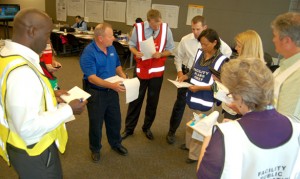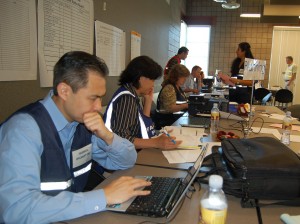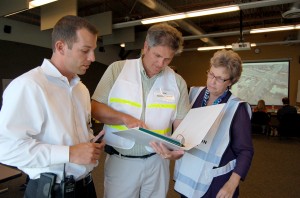
A chemical threat was reported by authorities following the detonation of an explosive device planted on a rail car in the Alameda Corridor, posing a life-threatening hazardous materials danger several miles wide. That was the scenario set by the Federal Emergency Management Agency (FEMA) and emergency agencies from the City of Compton for a practice exercise held on July 11 that was meant to prepare the municipality for a real-life large-scale disaster.
To hone its own response in case of emergencies on or affecting the campus, the Emergency Operations Center (EOC) team at California State University, Dominguez Hills participated in the drill.
“The Emergency Operations Center team occasionally performs these exercises in preparation of a real emergency. If we practice during times of low stress, we will be better prepared to handle the stress of a real emergency. This also gives us a chance to mitigate any small problems that may arise during the real thing,” said Gary Singer, emergency management and preparedness coordinator.

Thirty-plus employees from departments throughout the university, who have all been trained using state and federal emergency management protocols, make up the EOC team. They are responsible for managing and coordinating responses to emergencies affecting campus, and working with campus police as well as local, state and federal agencies to communicate needs and priorities. This could include building evacuation, coordinating medical aid for the care of injured persons, assessing damages, determining and making needed repairs, or in the example of the EOC’s public information officer (PIO), communicating the situation to faculty, staff, students and the public.
“The role of the university’s communications staff in the EOC is to disseminate information and instructions to the campus community, to the public and to the media as to what the emergency or crisis is, and what they should know and do to help protect themselves and others,” said Brenda Knepper, director of university communications and public affairs and the EOC’s PIO.
As would be the case in the event of real emergency, the EOC set up in the Extended Education building auditorium for the mock drill and was equipped with functional telephones, police walkie-talkies, televisions for monitoring news, interactive maps, and laptop computers with Internet access. Members were in contact with the City of Compton and were given status updates on how the “incident” was progressing. The CSUDH EOC then addressed the impact to campus and planned its response.
As a result of the exercise, Singer said the university EOC team fostered relationships with neighboring cities and law enforcement agencies.

“We worked closely with the City of Compton and their school police departments to make this exercise a success. We will continue to work with our neighbors in both the public and private sector to build a ‘whole community’ approach to emergency preparedness,” Singer said.
He iterated to the EOC team that the priorities–in this order–are to preserve life, to preserve property, and to return to normalcy.
For more information about emergency procedures on campus, visit the university’s emergency preparedness webpage.